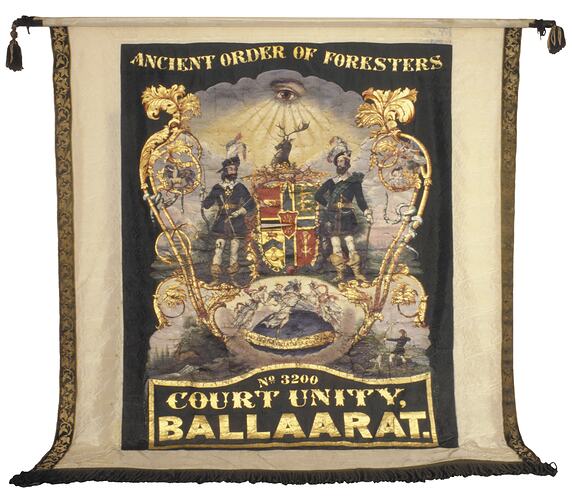Summary
Large banner. `Ancient Order of Foresters/No 3200/Court Unity/Ballarat.' Painted in oil paint on green taffeta. Central image is of the Foresters' emblem : includes seeing eye, deer, two Scottish men, coat-of-arms, etc., with motto : `Unitas Benevolentia at Concordia.' Signed at bottom : T. Flintoff, Ballarat. Taffeta backed with cotton; creamy white silk taffeta border, bordered in turn with a brocade strip with cream flowers and green brushed `velvet' background. Wool fringe with twisted strands. On wooden pole with tassels and metal chain.
Made by Thomas Flintoff, painter and photographer, in Ballarat, c.1860
Used: Ballarat, Victoria, Australia
Physical Description
Large banner. `Ancient Order of Foresters/No 3200/Court Unity/Ballarat.' Painted in oil paint on green taffeta. Central image is of the Foresters' emblem : includes seeing eye, deer, two Scottish men, coat-of-arms, etc., with motto : `Unitas Benevolentia at Concordia.' Signed at bottom : T. Flintoff, Ballarat. Taffeta backed with cotton; creamy white silk taffeta border, bordered in turn with a brocade strip with cream flowers and green brushed `velvet' background. Wool fringe with twisted strands. On wooden pole with tassels and metal chain.
Significance
This banner is illustrated in a photographed captioned "Laying of the Foundation Stone of the Ballarat Town Hall with Ballarat East in the background, c. 1860s." The photograph is in the collection of the Royal Historical Society of Victoria, and also in the collection of the Gold Museum, Ballarat, where it is dated 1861. See supplementary file.
This is an early surviving banner - possibly the earliest surviving - from an Australian Friendly Society. It was produced for the members of the 'Court Unity' of the Ancient Order of Foresters, meeting in Ballarat. It shows the emblem of the Foresters, with their motto 'Unitas Benevolentia et Concordia' or 'United in Charity and Friendship'.
In a world without social security, working men could see the value of joining together in 'Friendly Societies'. At the regular 'lodge' meeting, members would pay a small subscription, a form of insurance, which would entitle them to benefits if they became ill or unemployed, and would provide support for their dependents if they died. Lodge members took turns to assume leadership positions. Often they ran the finances of each lodge with only minimal interference from a central organisation. Members identified proudly with their society, wearing elaborate regalia at meetings, and learning complicated initiation rites and the rituals associated with membership.
This banner was made by Thomas Flintoff, artist and photographer, in his Ballarat workshop. It is painted in oil on green taffeta backed with cotton, with a wide white border edged with brocade. Banners such as these were hung in the meeting rooms of lodges, and were carried by lodge members in regalia during civic processions and celebrations. There is a photograph of this banner being displayed at the laying of the foundation stone of the East Ballarat Town Hall in 1861.
Thomas Flintoff (1809-1891) worked in Ballarat between c.1856 and 1872. The Museum has two of his banners; he also produced 'infallotypes', a variety of daguerrotypes, and oil portraits of many of the colony's leading citizens. Before arriving in Ballarat in the early 1850s, he was an itinerant painter who worked in England, Mexico, Texas and the Society Islands. He moved to Melbourne in 1872 and exhibited with the Victorian Academy of Arts.
More Information
-
Collection Names
-
Collecting Areas
-
Acquisition Information
Donation from Manchester Unity, 16 Jan 1989
-
Artist
-
Place Used
-
Inscriptions
Text: ANCIENT ORDER OF FORESTERS/ No 3200/ COURT UNITY, BALLAARAT.
-
Medium
Oil
-
Technique
Painting
-
Support
Taffeta and Cotton
-
Primary Inscriptions
ANCIENT ORDER OF FORESTERS/ No 3200/ COURT UNITY, BALLAARAT.
-
Classification
-
Category
-
Discipline
-
Type of item
-
Overall Dimensions
292 cm (Width), 376 cm (Height)
-
Maximum dimensions
3160 mm (Width), 3615 mm (Height)
Measurement From Conservation. (215 mm of fringe on lower edge included in these dimensions. Without fringe the height is 3400 mm)
-
References
D.I.Stone, ed. 'Gold Diggers and Diggings: a photographic study of gold in Australia, 1854 - 1920'. Lansdowne Press, 1974, p.59
-
Keywords
